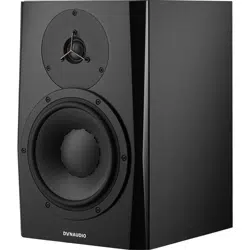Loading ...
Loading ...
Loading ...

DSP Settings
Dynaudio engineers have painstakingly created a DSP controller for these speakers that lets you tailor the sound
to your particular environment. The DSP settings provide precision adjustments that optimize the speakers for the
listening space.
Bass Extension
Low frequencies take an exponentially larger amount of energy to reproduce than high frequencies. That is why
the bass extension setting aects how loud the speaker will respond.
At its lowest setting (-10 Hz), the low frequency range is extended by 10Hz. This will also reduce the maximum
volume that the speaker can achieve. The default setting of 0 Hz limits the range of low bass while increasing the
maximum volume of the loudspeaker. The +10 Hz setting has the least amount of bass extension but the loudest
volume possible from the loudspeaker.
▪ -10 Hz (greatest low frequency extension, - 5 dB output)
▪ 0 Hz
▪ +10 Hz (loudest output with least low frequency extension, +5 dB output)
As most professional mixers tend to mix at relatively low volumes (~70-85 dB SPL), the greatest amount of bass
extension (-10 Hz) can be used. As you increase the playback volume, you may need to reduce the amount of
bass extension in order to prevent overdriving the loudspeaker.
Sound Balance
The sound balance, or tilt filter, represents a refined way to aect the overall tone of the speaker. Depending on
the room treatment among other factors, it may be necessary to make the loudspeaker darker or brighter than the
normal setting. A dead sounding room with a great deal of treatment might need a brighter setting than a live room
with many reflective surfaces.
Sound Balance has three settings:
▪ Bright (20 Hz -1,5dB, 20kHz +1,5dB)
▪ Neutral
▪ Dark (20 Hz +1,5dB, 20 kHz -1,5 dB)
What this filter actually does is tilt the entire spectrum by 1,5 dB at either end using minimal phase or linear phase
filters to either brighten or darken the overall response. This minimal filter alters the tonality without inducing audible
phase anomalies, thereby maximizing the linearity of the loudspeaker.
Position
If you have positioned your speakers within 50cm of a back wall boundary, the position switch should be placed
in the “Wall” setting. This will help with anomalies created by reflections coming o the back wall, especially in the
lower frequencies. If your speakers are placed further than 50cm from any wall surface, use the “Free” setting.
DSP Settings 19
Loading ...
Loading ...
Loading ...
